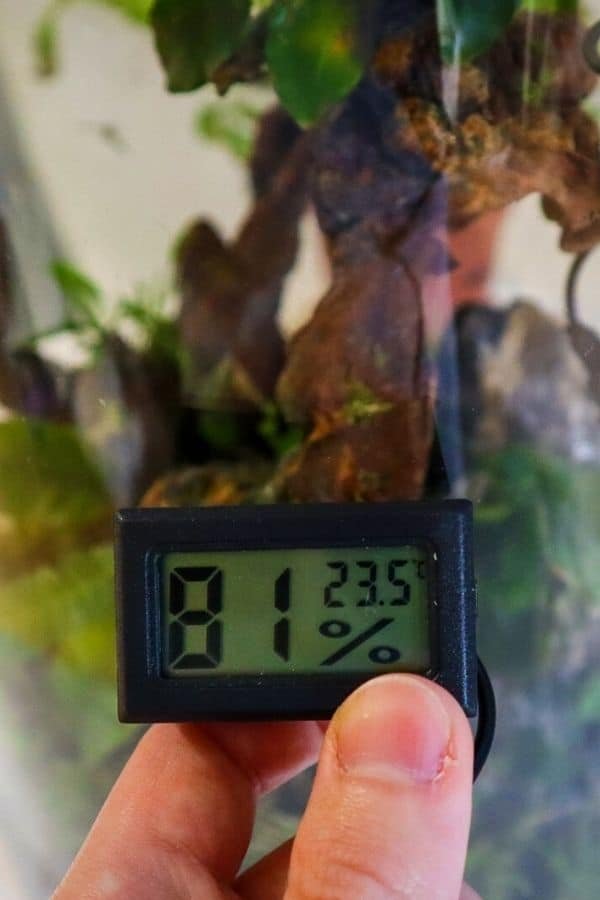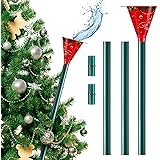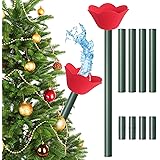Looking to reduce the humidity in your terrarium? Look no further! Lowering humidity levels in your terrarium is essential for creating a healthy and thriving environment for your plants and pets. High humidity can lead to mold, fungus, and undesirable moisture levels.
But fear not! In this article, we will show you exactly how to lower humidity in your terrarium, ensuring optimal conditions for your beloved plants and creatures. So, let’s dive right in and discover the simple yet effective solutions to create the perfect habitat for your terrarium!
How to Lower Humidity in a Terrarium
Terrariums are a popular way to bring nature indoors and create a miniature ecosystem. However, maintaining the right humidity level is crucial for the health and well-being of the plants and animals living inside.
Excess humidity can lead to mold growth, fungal infections, and other issues. In this article, we will explore effective methods to lower humidity in a terrarium, ensuring a healthy environment for your plants and pets.
Understanding Humidity in Terrariums
Before we dive into the strategies to lower humidity, let’s first understand the factors that contribute to high humidity in a terrarium:
1. Watering:
Overwatering plants or using excessive misting can increase humidity levels inside the terrarium.
2. Enclosure Design:
The type of terrarium and its ventilation system can affect humidity retention.
3. Substrate Choice:
Certain substrates, such as moisture-retaining soil mixes, can contribute to higher humidity levels.
4. Placement:
The location of the terrarium, including proximity to sunlight and heat sources, can impact humidity levels.
Now, let’s explore effective ways to lower humidity in a terrarium:
1. Adjust Watering Practices
Proper watering techniques play a vital role in controlling humidity. Follow these tips to minimize excess moisture:
- Water plants sparingly:
Avoid overwatering, as it can contribute to high humidity levels. Research the moisture requirements of the plants in your terrarium and water accordingly.
- Use a watering can with a narrow spout:
This allows you to target specific areas without drenching the entire terrarium.
- Avoid misting:
While misting can be helpful in increasing humidity, it can also lead to excess moisture buildup.
Instead, opt for alternatives like a humidifier placed near the terrarium.
2. Improve Ventilation
Proper airflow is essential for controlling humidity. Here’s how you can enhance ventilation in your terrarium:
- Opt for a terrarium with ventilation holes:
Choose an enclosure with adequate air circulation to prevent excessive humidity retention.
- Open the terrarium periodically:
Allow fresh air to enter by slightly lifting or removing the lid for a short time each day.
- Install a small fan:
Placing a small, low-speed fan near the terrarium can improve air circulation and reduce humidity levels.
3. Choose the Right Substrate
The type of substrate you use can greatly affect the humidity levels in your terrarium. Consider these options:
- Well-draining soil mix:
Opt for a soil mix that drains well, allowing excess water to escape and preventing moisture buildup.
- Incorporate perlite or sand:
Adding perlite or sand to the soil mix can improve drainage and reduce humidity levels.
- Use a moisture-absorbing layer:
Place a layer of activated charcoal or sphagnum moss at the bottom of the terrarium to absorb excess moisture.
4. Monitor Placement and Lighting
The location and lighting conditions can impact humidity levels in your terrarium. Consider the following:
- Avoid direct sunlight:
Placing the terrarium in direct sunlight can increase temperatures and humidity levels. Choose a location with indirect or filtered light.
- Keep away from heat sources:
Avoid placing the terrarium near heat-emitting appliances or heating vents, as they can elevate humidity levels.
- Consider a cool mist humidifier:
If your terrarium requires higher humidity levels, consider using a cool mist humidifier placed near the enclosure. This allows precise control over the humidity levels.
5. Use a Dehumidifier
In situations where other methods fail to lower humidity effectively, using a dehumidifier can be an excellent solution. Dehumidifiers remove excess moisture from the air, helping to maintain a healthy humidity level in the terrarium. Place the dehumidifier near the terrarium and adjust the settings based on the desired humidity level.
Remember to regularly monitor the humidity levels inside the terrarium using a hygrometer. Aim for a range that suits the specific needs of your plants and animals. By implementing these strategies and finding the right balance, you can create an optimal environment for your terrarium inhabitants.
We hope this guide has provided you with valuable insights and practical solutions to lower humidity in your terrarium. With proper care and attention, you can create a thriving ecosystem that brings joy and beauty to your indoor space.
Frequently Asked Questions (FAQs)
Yes, using a dehumidifier is an effective way to reduce humidity levels in your terrarium. Place the dehumidifier near the terrarium to remove excess moisture from the air.
Absolutely! Proper ventilation is crucial for controlling humidity in a terrarium. Make sure your terrarium has enough air vents or openings to allow for adequate airflow.
Yes, certain plants are known for their ability to absorb excess moisture. Adding plants like air plants, spider plants, and snake plants to your terrarium can help lower humidity levels.
Yes, silica gel packets can be used to absorb moisture and lower humidity in a terrarium. Place a few packets inside the terrarium or near its openings to help control humidity.
Yes, reducing the frequency and amount of water you provide to your terrarium can help lower humidity. Be mindful not to overwater the plants and avoid misting them too often.
No, covering your terrarium can trap moisture and increase humidity levels. Instead, keep the terrarium uncovered or use a mesh or screen lid to promote airflow and control humidity.
The ideal humidity level for a terrarium depends on the specific plants and animals inhabiting it. However, a general guideline is to maintain humidity between 50% and 70% for most terrarium setups.
Final Thoughts
In order to effectively lower humidity in your terrarium, there are several strategies you can implement. Firstly, ensure proper ventilation by opening the lid or adding small fans. This will help circulate the air and reduce moisture buildup. Additionally, consider using a dehumidifier or silica gel packs to absorb excess humidity. Creating a drainage layer in your terrarium can also prevent water from accumulating at the bottom.
Lastly, regularly monitor and adjust watering routines to maintain optimal moisture levels. By following these tips, you can successfully lower humidity in your terrarium and provide a healthier environment for your plants and animals.
Auto Amazon Links: No products found.
Perfect Plants Christmas Tree Saver 8oz. | Easy Use Xmas Tree Preserver Food | Have Healthy Green Christmas Trees All Holiday Season
$9.97 (as of December 13, 2025 05:07 GMT +00:00 - More info- Product prices and availability are accurate as of the date/time indicated and are subject to change. Any price and availability information displayed on [relevant Amazon Site(s), as applicable] at the time of purchase will apply to the purchase of this product.
Rocky Mountain Goods Christmas Tree Food - 8 oz Tree Preservative - Reduce Needle Drop - Greener Scent - Fir, Pine, Spruce Trees - Extend Tree Life
$9.95 (as of December 13, 2025 05:07 GMT +00:00 - More info- Product prices and availability are accurate as of the date/time indicated and are subject to change. Any price and availability information displayed on [relevant Amazon Site(s), as applicable] at the time of purchase will apply to the purchase of this product.
FirEver Pure Christmas Tree Food | Preserver Additive & Season Extender for Live Xmas Trees | Keep It Green, Reduce Needle-Drop | Miracle Freshness (8 oz)
$14.99 (as of December 13, 2025 05:07 GMT +00:00 - More info- Product prices and availability are accurate as of the date/time indicated and are subject to change. Any price and availability information displayed on [relevant Amazon Site(s), as applicable] at the time of purchase will apply to the purchase of this product.
VICAMB 39.3 Inch Christmas Tree Watering Funnel,Christmas Tree Watering System Device,Long Tree Watering Funnel Spout for Indoor Outdoor Xmas Tree
$16.99 (as of December 13, 2025 05:07 GMT +00:00 - More info- Product prices and availability are accurate as of the date/time indicated and are subject to change. Any price and availability information displayed on [relevant Amazon Site(s), as applicable] at the time of purchase will apply to the purchase of this product.
EZMeetU Christmas Tree Watering Funnel, 47 Inch Flower Shape Adjustable 6 Section Design, Christmas Tree Watering System, Christmas Tree Waterer, Long Funnel Wide Opening Reusable, Plant Watering Tool
$16.99 (as of December 13, 2025 05:07 GMT +00:00 - More info- Product prices and availability are accurate as of the date/time indicated and are subject to change. Any price and availability information displayed on [relevant Amazon Site(s), as applicable] at the time of purchase will apply to the purchase of this product.
Snow Joe Premium Enviro Blend Ice Melt, Green-Coated Deicer Crystals, 50 lb - Safer Melter for Vegetation, Concrete & Metals w/ Anti-Corrosion Calcium Magnesium Acetate
$32.97 (as of December 12, 2025 19:27 GMT +00:00 - More info- Product prices and availability are accurate as of the date/time indicated and are subject to change. Any price and availability information displayed on [relevant Amazon Site(s), as applicable] at the time of purchase will apply to the purchase of this product.
Muddy Mat® Shown on TV Super Absorbent Microfiber Dog Door Mat for Muddy Paws, Non-Slip Washable Pet Rug, Quick Dry Chenille Entryway Carpet, Machine Washable Indoor Outdoor mat, Grey 30"x19"
$24.95 (as of December 12, 2025 19:27 GMT +00:00 - More info- Product prices and availability are accurate as of the date/time indicated and are subject to change. Any price and availability information displayed on [relevant Amazon Site(s), as applicable] at the time of purchase will apply to the purchase of this product.
ivtivfu Rolling Grill Basket, Removable Wooden Handle, 304 Stainless Steel, Nesting BBQ Tools, Smoker Grilling Accessories for Vegetable, Outdoor Cooking Camping, Birthday Gifts for Men Dad Husband
$25.99 (as of December 12, 2025 19:27 GMT +00:00 - More info- Product prices and availability are accurate as of the date/time indicated and are subject to change. Any price and availability information displayed on [relevant Amazon Site(s), as applicable] at the time of purchase will apply to the purchase of this product.
XXXFLOWER Plant Terrarium with Wooden Stand, Air Planter Bulb Glass Vase Metal Swivel Holder Retro Tabletop for Hydroponics Home Garden Office Decoration - 3 Bulb Vase
$18.98 (as of December 12, 2025 19:27 GMT +00:00 - More info- Product prices and availability are accurate as of the date/time indicated and are subject to change. Any price and availability information displayed on [relevant Amazon Site(s), as applicable] at the time of purchase will apply to the purchase of this product.
Zevo Flying Insect Trap Official Refill Cartridges - Fits Both Zevo Trap & MAX Indoor Fly Trap - Authentic Trap+Lock Technology to Catch Gnats, House & Fruit Flys (4 Official Refill Cartridges)
$14.97 (as of December 12, 2025 19:27 GMT +00:00 - More info- Product prices and availability are accurate as of the date/time indicated and are subject to change. Any price and availability information displayed on [relevant Amazon Site(s), as applicable] at the time of purchase will apply to the purchase of this product.











